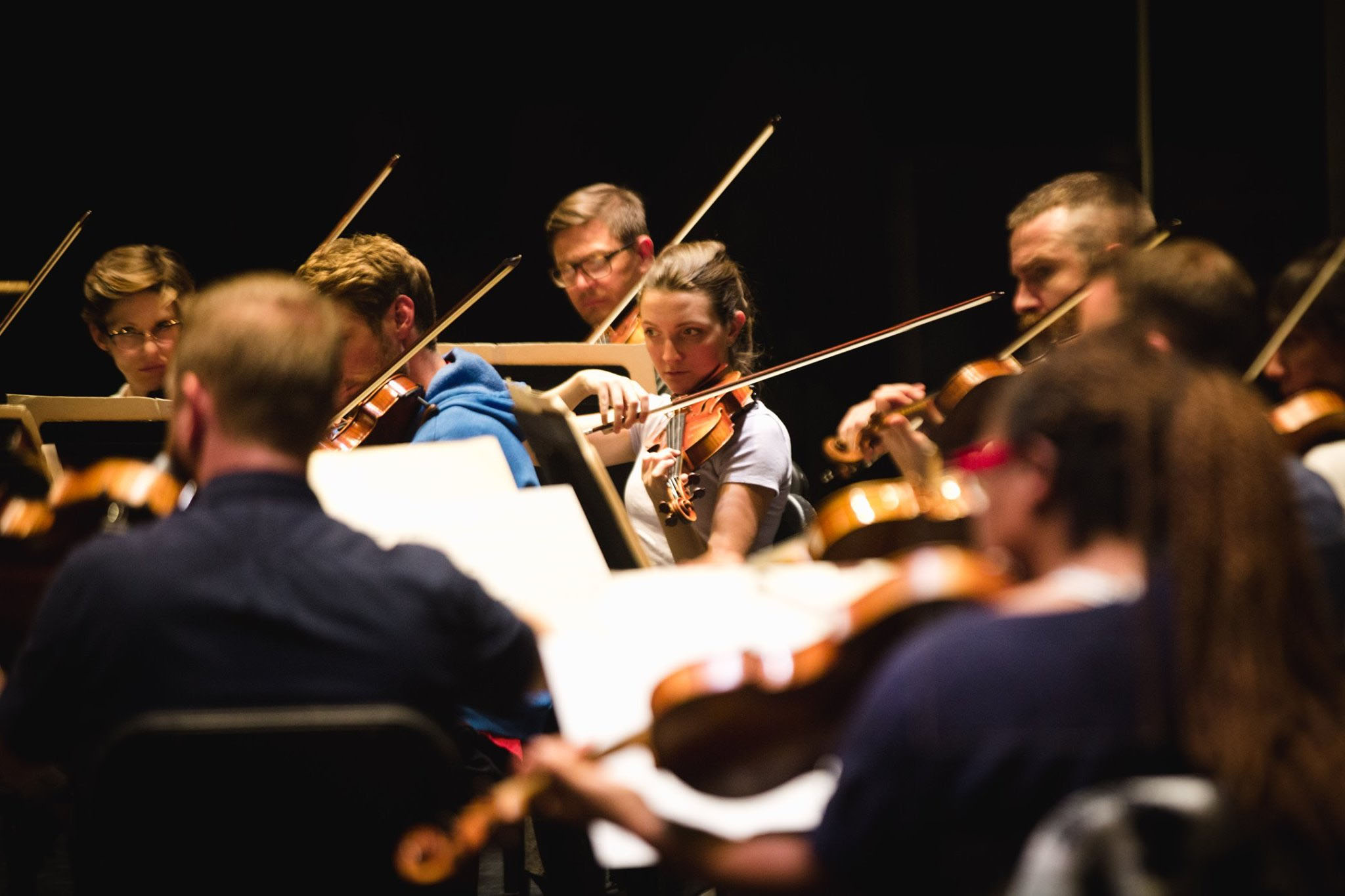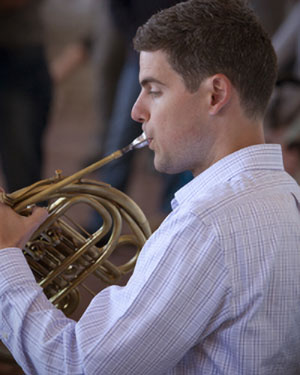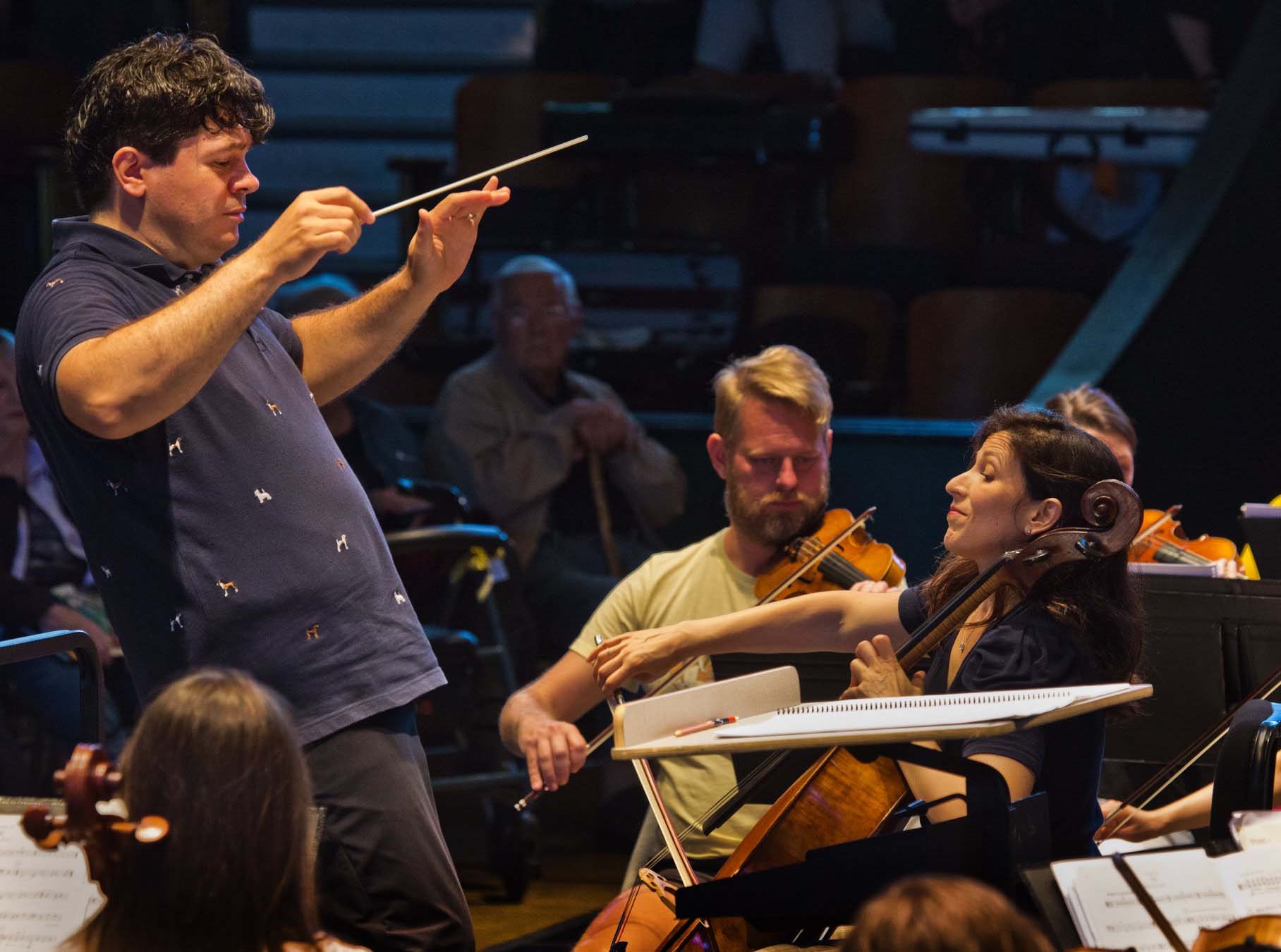
It is Thursday of the first week of the Festival, and there has been so much to take in that I’ve had trouble deciding where to begin this post. From Open Rehearsals to Student Staff projects, Megan Levad’s poetry workshop, and the astounding In the Works concert, this Festival is brimming with personal and collective creative growth. I’ve observed the deep exploration and innovation that occurs within the Festival space and I’ve already begun to see how this impacts the Santa Cruz community. It seems to me that by opening these artistic processes to the public, the community becomes a part of those processes. Every person that is in the open-rehearsal space in some way contributes to the shared energy that the Festival is so known for. When an audience is able to gain an understanding of what is involved in preparing a work—when they’ve seen it evolve and when they can say, “I was there when that musician made the decisions to play ___like ___”—that work is likely to become more meaningful to them. Of late, I’ve been thinking about just how relevant this priority of process is to the Festival’s focus on Justice Ruth Bader Ginsburg. In the 2018 documentary, RBG, her strategy of working towards women’s equality is compared to knitting a sweater. She was said to work step by step—case by case. Justice Ginsburg’s impact has been great, but to truly understand that impact, it’s important to think about the “small” moves she made and continues to make in her career. No great things, political or artistic, or, political and artistic (as many of the works in Cabrillo’s 2019 season are) just happen. Great things are always in process. When we veil that process, as so often happens in the performance art world, we then put the product on a pedestal; and as a result, view that product as finished, separate from us and our lives, and untouchable. We are less invested or involved in that product.
While one argument for closing off rehearsal processes entirely might be that the “magic” of the artistic product is reduced when we’ve seen it in production, magical was how I’d describe the experience of witnessing the Festival Orchestra rehearse Notorious for the first time. When Cristi brought his hands together and cued the swelling, tinkering sounds of Nina Young’s Agnosco Veteris, I had the feeling that the music came out of nowhere. I couldn’t believe that this was the first time these musicians had played the piece together. I wondered: when did they start rehearsing this work on their own? What does it feel like to sit with people you haven’t seen in a year and collaboratively bring a piece into the space? I had the sense that the newness of the work was felt and shared between the orchestra and the audience—and not because it sounded under-rehearsed, but because of the observable physical engagement of everyone involved. Audience members were either leaning forward in their seats and looking around the orchestra, attempting to locate the source of the various phrases; or they were sitting back, concentrating with their eyes focused down as they moved ever so slightly with the ebbs and flows of the music. At one point during Young’s piece, both I and the man in front of me were growing with the orchestra as the music became larger and louder, both of us sitting taller in our seats until we dropped our heads in unison with the culmination of the crescendo. It wasn’t until we dropped our heads together that I noticed our similar responses.
 Wanting to know what this first open rehearsal might have felt like for the orchestra members, I sat down with Co-Principal Horn and Orchestra Manager, Gavin Reed. Here are some highlights from our conversation:
Wanting to know what this first open rehearsal might have felt like for the orchestra members, I sat down with Co-Principal Horn and Orchestra Manager, Gavin Reed. Here are some highlights from our conversation:
On the musicians’ preparation period:
G: Typically, we get the music about a month, maybe (hopefully) a little bit more than that in advance of the Festival. Sometimes before premieres, we get parts very late because our composers are not finished writing, but we get about a month to prepare five programs worth of music. It’s a ton of stuff to get ready and it’s a lot of responsibility, and that’s why it’s so important we have a really great librarian who is organized and can get all of those things sent out as soon as they’re ready. Some other festivals like Grand Teton Music Festival or Sun Valley Summer Symphony are playing fairly standard repertoire–a meat and potatoes rep that everybody knows. That rep doesn’t take very much rehearsal time and they don’t need their music months in advance.
G: There’s one other orchestra that spends substantial time together only playing new music. We’re a weird animal.
On the rotating string section:
G: There are rare instances where we’ll rotate a little bit, especially if the program is particularly strenuous, we’ll try to split it up so that no one person is having to do so much heavy playing. But for the most part, in the winds and the brass, you sit where you sit. In the strings at Cabrillo, we have what you call a rotating section, so we have the principle players sit in the front row (they stay where they are the whole time) while everybody else is on a rotating basis. It’s random and you’ll see no one person will be in the same place twice, so that’s a challenge. That’s also part of my job; setting the string rotations.
On the feeling of sitting in the orchestra and bringing the music to life for the first time:
G: At that first service there’s always that feeling that it’s the beginning of summer camp, like we literally say those words out there…so it’s exciting. And you see your friends that you haven’t seen in 50 weeks. And then you really have no idea what anything sounds like except your own part. So, it’s always exciting to see how things fit together.
S: Are you only tuned into your section or are you aware of how things are coming together as a whole?
G: Both. You have to do as much as you can to play what you prepared, but you also have to have an ear out for balance. You have to quickly deduce whether your part is the main event or not and if it’s not, then you shouldn’t be playing as loud as you can. So, you’re focused on your part and how it fits into the whole and you’re also responding to what the conductor is asking you for.
S: So many wheels turning at once.
G: Yes, it’s a big cooperative family trying to get along the whole time…
S: with dad jokes helping you out [referring to Cristi’s sense of humor]
G: There you go. So you’re trying to fit in with people right next to you. Like for example in the horns, I’m trying to play with the first player (sometimes I’m the first player) but I’m listening to the second player closely and I’m also listening down the row (or up the row), trying to match—to play the same way. So, you’re doing that while you’re controlling your own instrument, and then seeing what’s going on in your half of the orchestra, and then seeing what Cristi is asking for.
On what it feels like to be in an open rehearsal versus being in a closed rehearsal, as well as the value of open rehearsals:
G: I would say that open rehearsals at Cabrillo are more or less the norm and so it doesn’t feel terribly performative as compared to, you know, if I’m back at home, where if we have an open rehearsal it’s sort of a special occasion and you feel like you are performing to a certain extent. It doesn’t feel casual. Here it feels very casual and there’s very much a family atmosphere. That’s kind of the ethos of the Festival anyway. I think the value though is that our patrons love being near the experience of us doing our work. It’s not a concert, they actually get to see how the sausage is made—that it doesn’t start out as well as it ends up, and it’s important for them to see that it is not magic, that what we do is work, and requires training and sensitivity, and that there is a progression from whatever it was that we did today to tomorrow, which will be better than that and to the shows will be better still. So it’s good for them to see that and to know that what musicians do is the result of hard work and sweat—not fairy dust.
S: It still felt like fairy dust, I have to say.
G: (excitedly) It’s a really good orchestra, right? So you’re talking about super fine players who already learned their music—who already got it as ready as they could before they showed up. So there’s a super high level of integrity among our players here. It’s a really unique place. People are very enthusiastic here.
On the emphasis of the artistic process at the Cabrillo Festival and the incorporation of the process into the product:
G: In many ways, our product is the rehearsal—it is the citizens of Santa Cruz getting to be a part of what it is to build a program from start to finish and we have such a huge turnout for open rehearsals that I think that’s what people get into. It ceases to be like voyeurism. They’re not looking through a crack in the wall, they’re in the room when these things are happening, so I think that’s the uniqueness of the Festival, and it’s important. I think that we should be doing that out in other places too—showing people how we do this. I can remember as a college student getting in trouble with the conductor because I stepped from the stage down into the audience and it was explained to me very clearly that you should never step over the proscenium, that we are here and they are out there.
…[on the concept of the “fourth wall,” or the imaginary wall that separates an audience from a performance]…Cabrillo is the opposite of the fourth wall. We’re eight feet from the front row chairs. So this is a real identifier for the festival, and I think every one of these players could be somewhere else, maybe making more money, certainly playing easier music, but I think they come because of the interactions with our fellow players and maybe more importantly with concert-goers. And of course, we’re in a unique position in that we stay with hosts and so those people not only are just hosts but are also avid fans of the festival. It’s really nice to develop those relationships. I see my host at every open rehearsal. So it’s a pretty special place.
During the first open rehearsal, I sat next to two regular concert-goers: Marilyn and Patti, both of whom have been attending the Festival for over 25 years. It was clear that their relationship with the Festival orchestra was of the kind that Gavin described. When I asked them why they kept coming back, Patti shared, “I live for this” and Marilyn explained: “It is one of the highlights of the year.” They commented on the “incredible and unusual musicians” and all of the “interactive stuff.” They also noted that it is uncommon for a conductor to have immediate input from a composer, and especially for an audience to be able to experience that dialogue.
One of my favorite aspects of the rehearsal was listening to the exchanges between Cristi and the composers. He’d ask questions like, “Do you want this release of the cello to have more of an aaaaaAH?” using vocalization to express the stylization he was going for. Or, he’d find very specific imagery to address the music quality. An example of this was when Cristi said to Kuster: “It should have a little bit of that lilt, huh?” And she clarified that what she wanted was “buoyancy, so it feels like jumping.” This clarification was important, having an obvious effect over the orchestra. It occurred to me just how linguistically oriented Cristi’s job as a translator of the score really is. He interprets/communicates the score with both his body and his words. Then, his interpretation is reinterpreted by each individual member of the orchestra and the orchestra as a collective. Because there are so many levels of communication happening throughout this process, the repeated question: “is that the right gesture?” is essential. The word gesture as it occurs in music is, to me, brilliantly all-encompassing because it acknowledges that the characteristics of melodies, phrases, chords progressions, etc., work together to create sonic movement, and that this movement is in relation with the movement of Cristi’s body. When he asks, is that the right gesture? He’s both asking “does that sound like it should?” and he’s asking “were my movements clear?”

At the beginning of the Conductors/Composers Workshop, Cristi shared a message on clarity that has stuck with me. He told the conductors that they would be clearest if they were themselves when they conducted. Emphasizing that he didn’t want them to try and be like him, Cristi explained that he wouldn’t be demonstrating anything. Rather, he would help them find their own kind of clarity. When I mentioned to Cristi that many of his comments felt applicable to me as a choreographer, he noted that the work of conducting and choreographing share the common goal of communicating through the physical body. This left me considering what I might learn about organic, efficient, and poetic physical communication from watching conductors closely. There is a balance of intention and spontaneity in their movements (even the most minute) that interests me. The conductor seems to use every part of their body, from their head to the tips of their fingers. The baton, when used, is like an extension of the arm, taking on the expressive potential of the body. As the Festival progresses, I’ll be paying attention to these qualities of the conductor, observing the processes and dialogues between Cristi, the composers, and the orchestra, so as to learn more about the potential of the gestural body in expression, translation, and communication.
In the next post, I will share a conversation that I had with composer, Maya Miro Johnson, in which she addresses the function of the score in communicating gesture(s) to an orchestra, which is mediated by the conductor. She also shares her thoughts on musical composition; the concept behind her work, change is the only constant, which was a part of In the Works; as well as her philosophies on the role of the artist/art-making.
